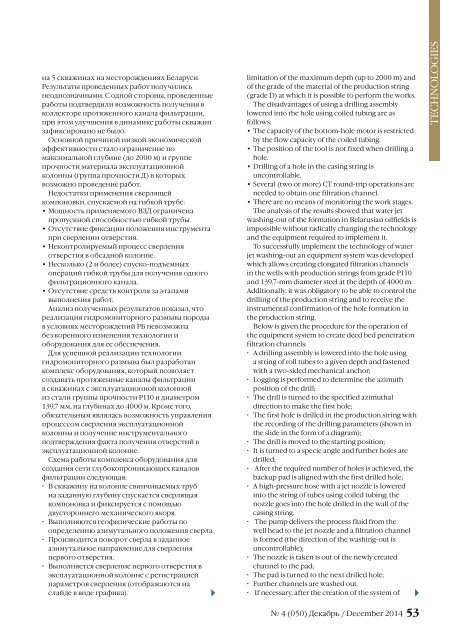issue-50_v1
issue-50_v1
issue-50_v1
You also want an ePaper? Increase the reach of your titles
YUMPU automatically turns print PDFs into web optimized ePapers that Google loves.
на 5 скважинах на месторождениях Беларуси.Результаты проведенных работ получилисьнеоднозначными. С одной стороны, проведенныеработы подтвердили возможность получения вколлекторе протяженного канала фильтрации,при этом улучшения в динамике работы скважинзафиксировано не было.Основной причиной низкой экономическойэффективности стало ограничение помаксимальной глубине (до 2000 м) и группепрочности материала эксплуатационнойколонны (группа прочности Д) в которыхвозможно проведение работ.Недостатки применения сверлящейкомпоновки, спускаемой на гибкой трубе:• Мощность применяемого ВЗД ограниченапропускной способностью гибкой трубы.• Отсутствие фиксации положения инструментапри сверлении отверстия.• Неконтролируемый процесс сверленияотверстия в обсадной колонне.• Несколько (2 и более) спуско-подъемныхопераций гибкой трубы для получения одногофильтрационного канала.• Отсутствие средств контроля за этапамивыполнения работ.Анализ полученных результатов показал, чтореализация гидромониторного размыва породыв условиях месторождений РБ невозможнабез коренного изменения технологии иоборудования для ее обеспечения.Для успешной реализации технологиигидромониторного размыва был разработанкомплекс оборудования, который позволяетсоздавать протяженные каналы фильтрациив скважинах с эксплуатационной колоннойиз стали группы прочности Р110 и диаметром139,7 мм, на глубинах до 4000 м. Кроме того,обязательным являлась возможность управленияпроцессом сверления эксплуатационнойколонны и получение инструментальногоподтверждения факта получения отверстий вэксплуатационной колонне.Схема работы комплекса оборудования длясоздания сети глубокопроникающих каналовфильтрации следующая:· В скважину на колонне свинчиваемых трубна заданную глубину спускается сверлящаякомпоновка и фиксируется с помощьюдвустороннего механического якоря.· Выполняются геофизические работы поопределению азимутального положения сверла.· Производится поворот сверла в заданноеазимутальное направление для сверленияпервого отверстия.· Выполняется сверление первого отверстия вэксплуатационной колонне с регистрациейпараметров сверления (отображаются наслайде в виде графика).limitation of the maximum depth (up to 2000 m) andof the grade of the material of the production string(grade D) at which it is possible to perform the works.The disadvantages of using a drilling assemblylowered into the hole using coiled tubing are asfollows:• The capacity of the bottom-hole motor is restrictedby the flow capacity of the coiled tubing.• The position of the tool is not fixed when drilling ahole.• Drilling of a hole in the casing string isuncontrollable.• Several (two or more) CT round-trip operations areneeded to obtain one filtration channel.• There are no means of monitoring the work stages.The analysis of the results showed that water jetwashing-out of the formation in Belarusian oilfields isimpossible without radically changing the technologyand the equipment required to implement it.To successfully implement the technology of waterjet washing-out an equipment system was developedwhich allows creating elongated filtration channelsin the wells with production strings from grade P110and 139.7-mm diameter steel at the depth of 4000 m.Additionally, it was obligatory to be able to control thedrilling of the production string and to receive theinstrumental confirmation of the hole formation inthe production string.Below is given the procedure for the operation ofthe equipment system to create deed bed penetrationfiltration channels:· A drilling assembly is lowered into the hole usinga string of roll tubes to a given depth and fastenedwith a two-sided mechanical anchor;· Logging is performed to determine the azimuthposition of the drill;· The drill is turned to the specified azimuthaldirection to make the first hole;· The first hole is drilled in the production string withthe recording of the drilling parameters (shown inthe slide in the form of a diagram);· The drill is moved to the starting position;· It is turned to a specie angle and further holes aredrilled;· After the required number of holes is achieved, thebackup pad is aligned with the first drilled hole;· A high-pressure hose with a jet nozzle is loweredinto the string of tubes using coiled tubing; thenozzle goes into the hole drilled in the wall of thecasing string.· The pump delivers the process fluid from thewell head to the jet nozzle and a filtration channelis formed (the direction of the washing-out isuncontrollable);· The nozzle is taken is out of the newly createdchannel to the pad;· The pad is turned to the next drilled hole;· Further channels are washed out.· If necessary, after the creation of the system of№ 4 (0<strong>50</strong>) Декабрь / December 2014 53Technologies


